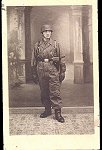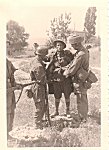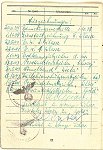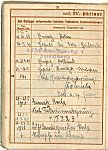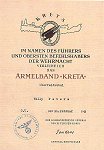
By COL Scott Pritchett
The Battle
The battle for the Island of Crete began on May 20, 1941. A succession of
factors drew the war to this Mediterranean island in a spectacular fashion.
The previous month, as part of the continued effort to knock the British out of
the war, the Germans had concluded the campaign in Greece, ejecting the British
and Commonwealth forces from the peninsula. However, the British had
successfully withdrawn substantial numbers of troops between 24 April and 1 May,
many evacuating to nearby Crete. The island, always important to the
British, now took on added significance for each side. For the British, Crete
provided a naval base in the eastern Mediterranean from which to continue to
attack German shipping transporting men and materiel to North Africa. For
the Germans, gaining possession of the island would provide them a base from
which the Luftwaffe could operate in support of Rommel’s Duetsches Afrika Korps.
Rommel’s hastily undertaken offensive between March and May had run its course
and his forces were in need of supplies and refitting. However successful he had
been in driving the British back, he had failed to take the British port of
Tobruk and his Afrika Korps was now over extended. The port stood in his
rear and astride his ever-lengthening lines of communication. He needed Tobruk
both to eliminate the threat to his lines and to use it as a logistics base to
support his continued drive toward Egypt. Seizure of Crete would greatly assist
him in this endeavor. Rommel pushed hard for the attack on Crete. The
attack was set for the end of April (although postponed for two weeks due to
supply and troop marshalling problems) by Fuhrer Directive No. 28 and was
code-named Operation Mercury (Merkur).
The campaign for Crete took longer than anticipated. What was designed as a coup
de main, took several weeks - time that the Germans could ill afford. While not
widely recognized at the highest levels, time was becoming the hidden enemy of
the German strategy. This was especially true regarding the planned attack on
the Soviet Union. Each diversion of forces to areas in the Balkans,
Mediterranean and North Africa were taking precious weeks out of the intended
attack East. The attack had already been postponed for the diversionary
campaigns in Albania and Greece.
Therefore, the key to attacking Crete was speed. This meant rapidly massing
combat forces and quickly overwhelming the enemy. As an island, Crete would have
to be assaulted from the air. This meant surprise was important for German
success. Surprise would both minimize the troops’ exposure against the
island’s defenses and quickly achieve the mission objectives, thereby reducing
German casualties. A period of bombing and strafing by the Luftwaffe in the days
preceding the assault were undertaken to reduce the defenses. The next two
phases of the German plan sought to mass quickly on the enemy by using the Luftwaffe’s airborne/ Fallshirmjäger forces in parachute and glider assaults
to attack and seize key airfields and ports on the first day. The principle
objectives were Maleme Airfield and Canea, Crete’s capital city with its port
in Suda Bay, and the Ritimo and Heraklion airfields. These objectives would
secure the means to introduce additional Heer forces - in the form of an elite
mountain infantry/Gebirgsjäger division - by airland and sea transport on the
second day. These forces were to expand the airhead and, in conjunction with the Fallshirmjäger, defeat the remaining enemy and secure the island.
The actual attack employed the largest use of airborne forces in history up to
that point in time. About 600 aircraft of the XI Flieger Korps delivered
approximately 10,000 Fallshirmjäger by parachute assault, 750 by glider borne
assault, and another 5,000 troops by airlanding. The Kriegsmarine (which had no
real German Naval units participating, but rather used captured Greek transport
vessels from the previous month’s campaign) under Admiral Schüster, brought in
an additional 7,000 troops in by sea. The ground combat units that participated
included the 1., 2. 3. and 4. battalions of the Luftlande-Sturmregiment (Meindel),
the 1., 2. and 3. Parachute Regimenter of the 7. Flieger Division (Süssmann) and
the 5. Gebirgsjäger Division (Ringel) – the latter comprised primarily of the
85. and 100. Gebrigsjäger Regimenter, the 95. Gebirgs Artillerie Regiment, and
the 95. Motorcycle, Pionier, Panzerjäger, and Aufklärungs bataillionen. Forces
that served in the vicinity of Crete are reported to have included II Abteilung
Panzer Regiment 31., Schützen Battailon 55. (Mot), and Heeres Flakabteilung 609.
An additional 500 bomber, fighter and reconnaissance aircraft of the VIII
Flieger Korps supported the operation beginning 14 May with the bombing of
Allied positions and installations throughout Crete. German forces were under
the overall command of General der Flieger Kurt Student, commanding the XI
Fliegerkorps.
The 42,500 British, Commonwealth and Greek defenders, led by New Zealand Major
General Bernard Freyberg (commander of the 2nd New Zealand Division), gave a
good accounting of themselves. In addition to having the advantage of the rough
natural terrain, the Allied forces were greatly assisted by the fact that ULTRA
had discerned the German plan and thus, they were able to position their forces
to advantage. However, the bulk of the defenders were troops that had just
withdrawn from Greece, and had been forced to leave the bulk of their equipment
behind. These soldiers were unorganized, poorly equipped, and harried as a
result of their defeat from the previous month. On the other hand, the original
garrison on Crete of 5,000 British soldiers were well armed and equipped –
even possessing about twenty tanks and armored personnel carriers – and
provided the backbone of the overall stubborn defense. A relatively weak showing
by the RAF complicated the British effort further. Unlike the RAF, the Royal
Navy owned the Mediterranean and gave outstanding support throughout the battle.
Lastly, the island also had an active partisan force that caused the Germans
some additional challenges and assisted the British efforts by keeping the
Germans off balance, fighting in all directions and sustaining casualties.
The battle was a costly victory for the Germans. In all, German casualties were
extensive, especially from the airborne assault and from the stiff resistance
that met the initial airlandings of the Gebirgsjäger. The loss of surprise, as
well as the stubborn British defense and a valuable contribution from the Royal
Navy, which sunk a flotilla of German reinforcements, severely pressed the
Germans for two weeks. Although the Fallshirmjäger captured Maleme Airfield on
the second day, significantly improving their situation and allowing badly
needed reinforcements from the Gebirgsjäger, it took the next eleven days at a
cost of 5,000 men killed in action and the loss of 271 transport planes, in
addition to the destroyed flotilla, for the Fallshirmjäger and Gebirgsjäger to
prevail. In comparison, the defenders suffered 3,500 killed and wounded and
11,800 taken prisoner. Another 14,000 defenders were successfully evacuated, but
the Royal Navy lost three cruisers and six destroyers sunk and one aircraft
carrier, three battleships, six cruisers and nine destroyers damaged by
relentless Luftwaffe attacks.
By 1 June 1941 the island was securely in German hands and the battle ended.
While the Wehrmacht won the tactical victory over the Allies, it suffered
heavily to claim the battle’s laurels. Operationally, the island never
completely yielded its intended advantage of extending Germany’s air umbrella.
Events and decisions elsewhere (the Soviet Union), as well as continued Allied
naval superiority in the Mediterranean Sea and rapidly growing supremacy in the
air, largely marginalized Crete. The most telling loss was at the strategic
level. From this point on, Germany abandoned large-scale airborne operations.
General Student called Crete “the grave of the German paratrooper force”.
And it was. The Allies on the other hand, were gearing up to leverage that same
capability – a capability they would use most convincingly for the remainder
of the war. In fact, a comprehensive captured German report on the Crete
operation was the foundation for an Allied study toward planning the airborne
assault on D-Day.
The Germans, all the way through the end of 1944, made several much smaller
scale parachute assaults but these either failed, were undertaken only as
special operations or were so small as to be incapable of having a decisive
role. Of course, the Allies had to continue to take in to account the possible
employment of German paratroopers in an airborne role. But, Germany’s decision
was a clear self-admission that its means to absorb the costs associated with
such risks would in the future limit its undertakings. The Fallshirmjäger
continued to display astounding tenacity and extraordinary skill wherever they
were employed for the remainder of the war, earning their place as some of the
most respected and capable soldiers in the history of modern warfare. Likewise,
the Gebirgsjäger continued to be employed on every front as some of the Third
Reich’s most capable soldiers.
General Cufftitle Description
The > KRETA < cuffband was instituted on 16 October 1942, about five months following the conclusion of the battle (Army/Heer Regulations/Verordnungs Blatt 1942, Directive 23, page 457, No. 874; Air force/Luftwaffe: 1942 Directive 40, page 1403, No. 2519; Navy/Kriegsmarine: 1942 Publication 29, page 831, No. 721 and 1942 Publication 36, page 1000, No.901). The cufftitle was considered an award and was given to personnel who made a parachute or glider landing on to the island of Crete between 20 and 27 May, took part in the air campaign over Crete, or were in active service at sea in the Crete theater of operations up to 27 May 1942. The award title was made of yellow-gold embroidery on a white to slightly off-white background of a cotton cloth. The designers of this particular cufftitle seem to have been particularly influenced by Greek culture for their design, as the colors of white and gold are reminiscent of the state colors from ancient Athens. The embroidery consists of the word “KRETA”, executed in a Roman style font, the title word being bracketed at either end by what is described in most references as ‘Acanthus leaves’. In fact, the ‘leaves’ are more accurately described as an Acanthus ‘design’(which indeed draws its inspiration from the Acanthus bush). This design – referred to as an ‘acanthus’ - was widely used in ancient Roman and Greek architectural design as a decoration atop columns and other sculptures. The Acanthus (acanthus hiburtus) bush itself, is a thorny plant found in a number of countries throughout Asia. One has to wonder if the designer of the cufftitle saw some symbolism between the battle for Crete and the thorn of the Acanthus bush.

Obverse Detailed Description
The uniform width of the band is 33mm. The cotton-linen material of the
standard issue cufftitle shows a distinct diagonal weave pattern. The
cotton is a matt off-white and the weave is tightly made, displaying a diagonal
brick-like pattern that runs horizontally along the length of the band, with no
fussing of the material. Undoubtedly, variations were made from other
types of material, but that described is the standard, original issue and as
such, is unmistakable. The band is bounded top and bottom for the full
length with a gold-yellow, 3mm wide Russia braid or soutache’ chord. The
positioning of the braid is virtually tangent to the top and bottom edges of the
base cloth. Soutache’ is the standard material used in many Wehrmacht
cufftitles, some Luftwaffe cufftitles, on overseas caps of the Heer, and on
various insignia of all of the branches of service of the Wehrmacht. The
ends of the Russia braid/soutache’ where the cufftitle has been cut from a
roll and has frayed, will usually show the white inner cotton threads over which
the gold-yellow silk-rayon outer thread had been wrapped. Each of the
borders is machine sewn in place, usually with a gold-yellow thread to match the
color of the Russia Braid. Due to the quality of the materials and the
quality of the manufacture, these borders are sewn on very straight.
The letters in the title are machine embroidered in gold-yellow cotton thread.
The quality of the machine stitching of the embroidery is obvious but, upon
close scrutiny will in many places look slightly ragged along the vertical edges
of the letters. The height of all the letters is 14 mm. The width of the letters
is not uniform, with the vertical strokes (on the ‘K’, ‘R’, ‘E’, and ‘T’) being
uniformly 4 mm wide and flaring at the Roman-style endings to 5mm. Diagonal
strokes (on the ‘K’and ‘R’) are typically 2-3mm wide, flaring to 5mm on the
Roman-style ends. The construction of the diagonal strokes on the ‘A’ however,
have the introductory stroke, or left diagonal, 2-3mm wide and the ending
stroke, or right diagonal, 4mm wide, each again, ending in a 5mm wide
Roman-style flare. The only curvature occurs on the ‘R’ and it is not of uniform
width, varying from a narrow 2mm at top through a 3mm wide bend. Due to the
nature of the machine embroidery, as previously mentioned, one will find these
dimensions vary slightly from example to example. However, the variance is
typically less than 1mm, so anything exceeding these by more than that, should
be looked at more closely and taken in to consideration with other factors in
determining originality.
The Acanthus designs that bracket the title word are done in the same
gold-yellow thread as the title. These are 25mm at the widest points
measured vertically (the outside ends) and 10mm at the narrowest (inside
ends). At the widest horizontal width, the design is 10-11mm. The
designs consist of six spiked acanthus leaves arranged horizontally with three
on top and three on bottom, which enclose a fan-like acanthus flower. Two
vertical “S” scrolls connect the bases of the acanthus leaves on the
insides. Most references refer to two styles of this overall design: the
“seven - leaf” version and the “nine - leaf” version. Several
points should be made in this regard. First, the true leaves in the design
are the spiked leaves that bracket the overall design top and bottom.
These are not what are being counted to distinguish between the two styles of
cufftitle. Second, the collector jargon that distinguishes the seven and
nine leafed variations is referring to the count of the petals on the interior
fan-like design. As already indicated, this is actually a representation
of the flower found on that variety of Acanthus plant Lastly, none of the
references I have seen over the years picture the nine-leaf version, although
most refer to its existence. In preparing to write this article, I sought
out anyone who might have an example of the nine-leaf version so as to include a
picture of in this article and none surfaced. It is my personal opinion
that the nine-leaf version does not exist as an issue piece. Rather, it is
probably collector folklore at worst or the result of a one-time observation of
a privately purchased cufftitle in a collection at some point at best.
Anyone having an example or photo that clearly establishes this version is
encouraged to share it on the Forum. The photo below shows another
cufftitle obverse and reverse together.

Reverse Detailed Description
The reverse of the >KRETA< cufftitle shows two inward folds of base cloth, one at the top and one at the bottom. These folds are approximately 12-13mm deep and unfinished along the inner edges. As a result, the base cloth is usually frayed, displaying a number of loose threads. This is not an indication of a reproduction. Visible along the top and bottom edges of these folds is the underside machine stitching, usually in gold-yellow thread, but sometimes white, tan or a light grayish-tan. The ends of the cufftitle, if the example under study is full length, will show a single vertical machine stitch usually in the same thread color as above. This stitching established the length to be cut from a roll as well as served to bind the ends from unraveling. Frequently, cufftitles removed from uniforms will no longer be long enough to retain this, as the full-length version had plenty of excess to ensure a proper fit around the various cuff circumferences it was applied to. Uncut, a full-length >KRETA< cufftitle will measure approximately 44-45 cm.
When one pulls open the folds, the reverse machine embroidery of the title word and acanthus designs are completely visible. The reverse lettering looks somewhat like a negative image, the white threads of the base cloth generally covering much of the surface of the gold-yellow machine embroidery seen in full on the obverse. Some >KRETA< cufftitles were issued later in the war bearing an RbNr. Otherwise, markings typically should not be present.
Wear and Regulations
The >KRETA< cufftitle was authorized for wear by all branches of the Wehrmacht for those members who met the qualifications, save for the Waffen SS who had no role in the battle. Criteria for award followed these general guidelines:
-
Participation in a parachute or glider assault on Crete between the 20th and the 27th of March 1940
-
or…participated in air operations over Crete
-
or…participated in operations at sea around the island before 28 May 1942. This included Heer/Army personnel that were delivered to the island by boat on 19 May 1942.
|
Click on image to enlarge - (Eric Queen Collection) |
||
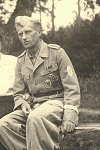 |
 |
|
| Former Army Fallshirmjäger Ernst Claus of 6./FJR 1 wears the KRETA cufftitle on his fliegerbluse in an early 1944 studio portrait. | Gerhard Broder of 1./ FJR 1 wearing the KRETA sleeveband on the tropical four pocket tunic | A German Cross winner and Kreta cufftitle recipient poses for a picture. |
Typically, a single example of the cufftitle was presented to the awardee. However, depending on where the award was made, such as in a training replacement unit, an awardee might receive up to three to attach to an array of uniforms. The cufftitle is almost universally seen affixed to only three kinds of uniforms, these being the service dress of the branch of service (Luftwaffe, Kriegsmarine or Heer), the overcoat/mantel and the combat dress. In all cases, the regulations prescribed wear on the bearer’s left sleeve, with the title to the front half of the sleeve and sewn approximately 15 cm above the lower edge of the field and service tunics, 7.5 cm above the cuff if worn on dress tunics and 1 cm above the open French cuffs on overcoats and officer private purchase field and service uniforms. Attachment to the uniform could be done by machine or by hand. Hand sewing was by far the more common method. Officers in particular were entitled to an orderly, one of which whose duties was to maintain the officer’s uniforms. This would have included sewing on rank at promotions, sewing on battle awards or seeing to it that uniforms received the appropriate loops for badge type awards. As such, hand sewing was common. When the recipient had earned more than one campaign cufftitle, the older award took precedence and was sewn above the new award. Reference books hold a number of photographs of Luftwaffe personnel in particular that were awarded both the >KRETA< and the AFRIKA campaign awards. The picture below is of a set, attached together properly and taken off a uniform.

Award Documents
An award document, or Urkunde was issued with the >KRETA< cufftitle and, as a campaign award, an entry was usually made in the soldier’s Soldbuch. This Solbuch entry usually can be found recorded using one of several phrases. The example below shows the typical phrase: ärmelband “Kreta”, with the quotation marks in proper German grammatical style, having the lead set of quotes below the K and the trail set above the T.
Another typically encountered entry (although finding a Kreta entry at all is relatively rare) is the phrase: Erinnerungsband “Kreta” (roughly translated as remembrance band Kreta). Dates of entry will vary, but should not show as having been made before the date of institution. The bulk of Soldbuch entries will show as the award of the cufftitle being made in late 1942 and throughout 1943. Some were made as late as 1944.
The soldier’s Wehrpaß would also be annotated to note the individual’s
participation in the battle or service connected with the campaign. This would
be found on pages 32 and 33 of the pre and early war Wehrpaß and on pages 30-33
on the late war Wehrpaß. Sometimes typed sheets of paper listing the battles
were glued in. Below is a photograph of the page from Army paratrooper Gotlieb
Moeck’s Wehrpaß. Note the entry “Einsatz KRETA nach fallshirmabsprung”
against the 20-28 May 1941 entry, documenting that Moeck actually participated
in the airborne assault.
Since each service had members who qualified for the award, variations of the
award document do exist. Standard document sizes are referred to by DINA
format and there are generally four accepted standard sizes. DINA3 is the
largest and runs 298mm wide by 420mm long. DINA6 is the smallest and runs
105mm wide by 150mm long. To date, I am aware of branch of service
specific award documents for the Luftwaffe and the Heer, as well as generic
versions used by each branch. Even though the Kriegsmarine was the first
branch of service to institute the award in 1942, I was unable to come across an
award document version specific to the service for this article. Dates on
award documents run from late 1942 all the way through 1944. Some of these
were done after the death of the awardees - who may have never received one for
various reasons (particularly if killed in action on Crete), or whose original
may have been lost. These documents were sent to the next of kin.
A version exists for Fallshirmjäger who participated in the campaign. It
is the most common version found, since the bulk of the troops who participated
in the campaign were paratroopers. It bears a sketch of the Luftwaffe
parachutists badge set above an outline sketch of the island of Crete, the word
“KRETA” imposed above. This version is always done in a combination of
brownish-red and black ink (the words Armelband Kreta being in brownish-red) and
will bear either an actual, facsimile, or stamped signature of General der
Flieger Student. The dates most were awarded were 11 Februar 1943 and 20 Mai
1943. While there were exceptions, these are rare.
The Gebirgsjäger also had a version. Pictured below, it was DINA5 (150mm by
210mm) and equally if not more ornate than the Fallshirmjäger version.
Bordered by a nearly continuous frame formed of three lines (thin, thick, thin)
with a single oak leaf at each corner broken at the top by a compact diorama
sketch of mountains, 2 sailing ships and 2 Ju-52 s (all either sailing or flying
to the viewer’s left), and having a facsimile of the >KRETA< cufftitle
in banner style centered and about 2/3 down from the top – all done in
reddish-brown or sepia-colored ink – the Gebirgsjäger version is very ornate
for an award document and highly collectible. A Major Vitale, prior to
October 1942, will have signed many. Others will be seen signed by a
battalion or regiment commander. The word “KURASCH” is found printed
at the center bottom in small letters and is probably the firm who was made
responsible for printing this special version.
Click on image to enlarge
The 12. Armee also had its own version. This Army, formed around 1940 and
having, taken part in the Western and Balkans campaigns remained in the Balkans
but was re-designated Armee Gruppe E in late1942 or early 1943. The 12. Armee
Urkunde for the >KRETA< cufftitle was in DINA5 format.
The award pictured below was made to Feldwebel Hain and is rare indeed, as so
few armored personnel took part in the battle. Hain was a member of
Schützen Regiment 55 and assigned to its reconnaissance unit.
Click on image to enlarge
Another version was done for flight personnel and signed by Generalfeldmarschall
von Richthofen over a generic signature block.
A final version worth noting was the field made version. It is safe to say that
just about every combat award at some point required or had a field version of
the document made. This was usually just a typed piece of paper measuring about
130mm high by 210mm wide. The verbiage varied, sometimes following closely that
found on the actual document. Sometimes it contained the word “Besitzzeugnis”
in its make up, indicating ‘in the possession of’, or “zur Verleihung,”
indicating the right or act of awarding. Other information on field made
documents usually seen is the individual’s name, his unit, the date time group
of the transmittal and award (including the hour the transmission was made in
some cases), and the signature blocks of both the rendering officer (the
adjutant most frequently) who will have initialed or signed the document, as
well as the commanding officer on whose behalf the rendering officer is acting.
The latter is usually a highly placed commander such as a Division, Corps or
Army commander.
Fakes and Reproductions
As most references on Third Reich collecting state, to try catalog the array
of fakes confronting the collector would be a work in itself. The >KRETA<
cufftitle is no exception. Fortunately for the collector, the >KRETA<
cufftitle as described above is for all intents and purposes the rule and what
one should look for when purchasing an original example. Original
cufftitles do come on the collecting market, but are fairly scarce. While
variations do exist (mostly private purchase or crude POW-made versions), the
collector should be cautious about any that do not meet the points described
above. A known variation was done on white wool with hand embroidery in
cotton gold-yellow cotton thread, but one should not expect to see such on the
market as the few known examples are mostly in private collections. The
>KRETA< cufftitle was a state award which qualifying members of
participating services were entitled to. As such, the state award met a
specific standard. Due to its inception in late 1942 and the relatively
small number needed (perhaps less than 100,000 were actually produced based on
the total size of the force that participated in the campaign being about
30,000), it was awarded and issued throughout most of the remainder of the war
and was available in necessary quantity. There was not a particular need
for different variations, or a continuing demand by those qualified to receive
it, since it was an award for a discrete event that was not repeated and the
population of survivors obviously dwindled as the war progressed.
Reproductions began at the end of WWII for the GI souvenir hunter and collector
interest back home. Some of these fakes, which were not really meant to
fool 50 years ago, are still available today. Fortunately, they were poor
likenesses of an original and so are fairly easy to spot today if one does not
get caught in the trap of seeing something that looks fifty years old and
rationalizing that it was an original, private purchase, variation. Others
were made for Hollywood movies toward the end of the war and well in to the 60’s.
These are generally very crude likenesses to an original and look like something
one would expect as a movie prop. Still others have been made for years
for German veterans’ organizations and handed out at reunions, for
example. For this reason alone a collector must be very cautious of any
>KRETA< cufftitle that does not meet the description above and comes with
a “got it from the German vet who earned it” story attached to it. Not
that these gents are on the take. Rather, some do not remember, some do
not recognize the difference from what they received in the war and what they
were given at the “five-year reunion” and relatives, who would not know the
difference have passed some on as well. Some veterans continued to serve
their country honorably in the Bundeswehr. In the 1950's the German
government recognized the contribution, sacrifices and battle honors that these
and other Germans rendered and earned. By 1957 the Bundeswehr had adopted
many uniform accouterments similar to the US Army. Of these, one of the
most noticeable was the wearing of stacked ribbon bars in an order of
precedence. The photo below shows an example bearing a ribbon for the >KRETA<
campaign award.

Modern fakes are the ones most meant to deceive – and they are widely available on the market. Some points, which should help discern these reproductions, are listed below.
- The cufftitle looks too clean and new and not made of the materials described above. Originals will have aged over 50 years and will not be white-white, some actually looking off white.
- Stiff feeling – the band does not go limp when hung over one’s extended finger.
- The tattered ends of the Russia Braid show a nylon-looking interior material.
- The band glows brightly under a black light
- It is made of white felt or white denim-looking material.
- The cufftitle is wider than the measurements described above.
- The embroidery is crude and does not meet the specifications above.
- The letters are connected/strung together by a single thread either on the obverse or reverse) where the forger has allowed the machine doing the embroidery to run non-stop.
- The embroidery, as seen from the reverse, looks almost white rather than mostly gold-yellow with white edges.
- The embroidered title and Acanthus design are visibly bowed top and bottom along the length of the embroidery.
A thin linen tissue cloth backs embroidery. - The entire cufftitle is backed with linen tissue cloth.
- The Russia braid is sewn too low on the white cloth band.
- The ends of the cufftitle, if full length, do not have the vertical stitching.
- The spiked leaves or the petals of the flower in the Acanthus design are not well defined because they a bunched too closely.
- The double “S” scrolls that run vertically on the inside edges of the Acanthus design are no “S’s but circles with dots inside.
- The thread used in the embroidery and the soutache’ shine rather than exhibit a dull cotton sheen.
Fake award documents and Soldbuch entries exist as well, although not as
frequently seen as the fake cufftitle. One should have some familiarity
with award documents in general to help detect the fakes, but the descriptions
above should help. As well, a thorough knowledge of the battle history,
unit history, and whereabouts, ranks and titles of personalities helps
significantly. It all ought to make sense and should be researched before a
purchase is made. For example, an award made before institution or
rendered to a unit that did not participate would be cause for concern.
Likewise, anything to the Kriegsmarine will be exceptionally rare and should be
thoroughly researched. Forged Soldbuchs are even more difficult to detect
but unfortunately are being done more and more. The same note of knowing
one’s history as well as gaining some experience recognizing proper entries is
applicable here as well.
Pictured below are a series of scans of a commonly found, rather good quality
fake. This reproduction cufftitle features some, but not all of the points
listed above.
I would like to mention that
several Forum members contributed to this article by sending me photos and
information. Eric Queen was very generous in providing many of the photos as
well as additional research and a review of the article. Mike Heuer and
Francois Saez also generously provided photos. Lastly, my new and good
friend Peter v Lukacs graciously allowed me to use the Hain document for the
article. It is this kind of participation and interest that helps make
this website such a success. Thank you.
![]()
© Copyright Wehrmacht-Awards.com LLC |
